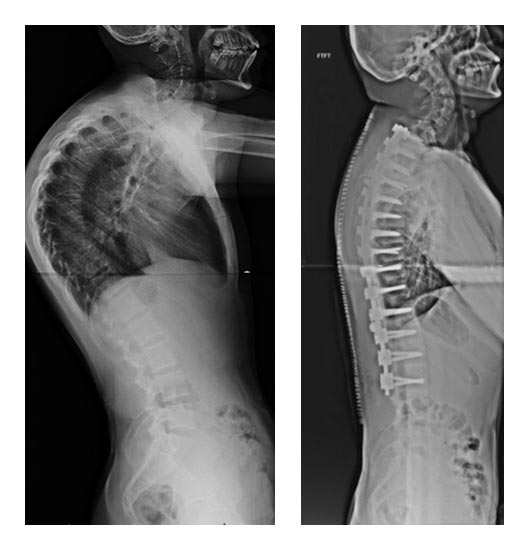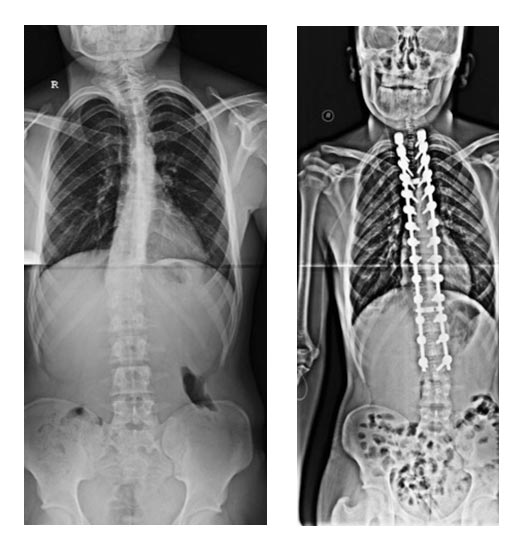Kyphosis

What is kyphosis?
Kyphosis, also known as a hunchback, is a disease in which the spine is bent forward. It is diagnosed by anatomically opposite curves in human spine when viewed from sideways. The curves balance each other out and the head stays in the same line with pelvis.
In which part of the spine does kyphosis occur most commonly?
Kyphosis occurs most commonly in the back. The upper limit of a normal kyphosis angle for this area is 50 degrees. The disease is occurred if the angle is wider.
Who may have kyphosis?
Kyphosis patients have their heads in front of their bodies when viewed from sideways. The curvature of kyphosis can be detected when the back is viewed from sideways. Some patients may also have a bigger dorsal cavity. These changes are difficult to see while dressed. So the patient should be examined in a state of undress. Parents generally detect kyphosis in their children during sea/pool activities in the summer.
What should parents do if they suspect kyphosis?
We spinal surgeons have a priority of preventing the misinformation of parents. Misinformation can lead to misdiagnose and false treatment. Reaching a spinal surgeon is the best they can do. The spinal surgeon can make angular measurement and affirm the diagnosis of kyphosis with advanced analyses (like x-ray, MR, tomography, etc.) when necessary.
What is the difference between a poor posture and kyphosis?
Some people hunch their backs as a habit. The difference between these people and kyphosis patients is their ability to stand upright when they want. Their angular measurement often results close to normal (under 60 degrees). The increased rib cage in some heavy sports and a bigger muscular mass may pull the spine forward, or the hunchback of teenage girls for the purpose of hiding their breasts are seen as poor posture.
Can poor posture turn into kyphosis?
Poor posture might lose its flexibility over time. Some ligaments in the spine might shorten and lead to kyphosis due to sprawling or humpback walking. They cannot stand straight even they want to. We can think of it as a turn into kyphosis.
So is treatment of poor posture important in preventing kyphosis?
Absolutely. Poor posture should be corrected in order to prevent future kyphosis.
What are the causes of kyphosis?
One of the most common causes of kyphosis is the poor posture in children. A second cause of kyphosis is Scheuermann’s disease. It is more common in men. This disease involves a slower growth in the frontal area of growing cartilages in the vertebral bodies compared to a normal growth of those in the back. The vertebral bodies eventually become shorter in the frontal area creating an irregularity and causing kyphosis. It generally occurs painless.
Congenital kyphosis emerges due to compression, irregularity or deficiency of the vertebrae. These types can be detected right after birth. Sometimes unions or compressions in the vertebrae can lead to an asymmetrical growth and ultimately kyphosis. It can also lead to short stature. This type of kyphosis progresses seriously and fast. It can be stopped and corrected through surgical treatment.
Elder people can have kyphosis due to spinal fractures based on bone loss. Spinal fractures based on collapses in the frontal area of consecutive vertebral bodies lead to hunchback. The important thing is to prevent these fractures. The collapsed vertebral bodies can be raised by vertebroplasty or kyphoplasty which then removes the hunchback.
What are the troubles of kyphosis patients?
The primary trouble is cosmetic since the curvature can be seen from sideways. Some patients also suffer from moderate back pain, back stiffness and a general fatigue due to muscle shortness. There may be other types of soreness in congenital kyphosis or in those based on spinal fractures.
Is it possible to prevent kyphosis? What can be done to prevent it?
Exercises for preventing kyphosis may work in those based on poor posture or Scheuermann kyphosis. The main principles are to extend abdominals, pectoral muscles, and leg muscles; and to strengthen the muscles around the spine.
How is the surgical treatment of kyphosis?
Surgical treatment is considered for patients with the highest curvature (75 degrees and above). Surgical treatment can correct the curvature and stop its progression.









